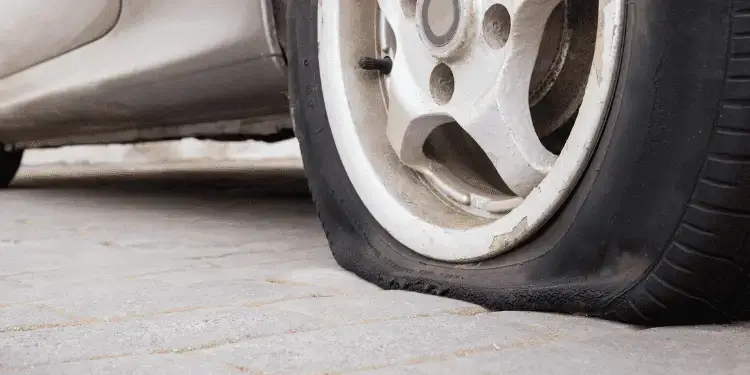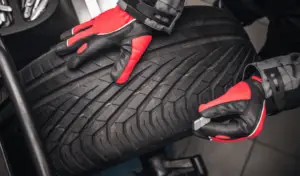Flat tires can be dangerous. That’s why it’s important to know the differences between driving on a front flat tire and a rear flat tire. This article will discuss how far you can drive on a rear flat tire and what precautions you should take if you find yourself in this situation.
Unlike the front ones, the rear wheels do not steer, which means that any instability caused by a flat tire will be less noticeable. Generally speaking, you should limit your driving on a rear flat tire to a few miles and no more than 15-20 mph.
In rear-wheel drive vehicles, the rear tires are responsible for providing power to the wheels, so driving on a rear flat tire can be especially dangerous.
First, the car will have less traction, making it more difficult to control.
Second, the car’s rear wheels will not be able to provide the same amount of power as they would if the tires were fully inflated. This can lead to a decrease in acceleration and an increase in fuel consumption.
Driving on a flat tire for too long can cause more damage to the tire, the rim, and the suspension, so getting it fixed as soon as possible is important.
Tire Damage
Driving on a flat tire can make the tire unrepairable if the sidewall comes into contact with the road.
The sidewall is often overlooked when assessing whether a tire is in good condition. Most people concentrate on tread depth or signs of dry rot.
Sidewalls are vital and support the weight of the car when inflated.

When the tire is flat, they collapse and, if driven for any distance, will rub against the road. Look for wear signs an inch or so from the tire shoulder.
If you see this, the tire will have to be replaced. Simply inflating the tire after patching a hole will not work. The sidewall is weak and can blow out at any time.
Rim Damage
When a tire is flat, it can no longer support the weight of the car, and the road forces exerted on it.
The tire will begin to flex and bend, causing the rim to rub against the ground. Over time, this can cause the rim to start to crack, deform, and eventually become irreparable.
This could happen in the first mile or after driving for ten miles, but it will happen.
Type of Tire
Run Flat Rear Tire Puncture
The average time you can safely drive on a run flat rear tire after a puncture is approximately 75-100 miles. However, this number is just an average and can vary depending on the type of tire, the speed, and the vehicle’s weight.
It’s worth noting that many sports cars like BMWs and certain Mercedes are rear-wheel drive and use run-flat tires as standard.
There is not much difference between how a run-flat tire will perform, whether for a front-wheel vehicle or a rear-wheel car, although you may notice skidding and lack of traction because of the drive location.
More in-depth information here: Can I Drive On A Run Flat Tire? [ANSWERED]
Condition of the Road
The condition of the road can also affect how far you can go on a flat tire. If the road is covered in deep potholes or has a lot of bumps, or is made up of gravel, it can be difficult, if not impossible, to drive on a flat tire.
Driving Style
How you drive can also influence how far you can go on a flat tire.
If you are driving aggressively and taking sharp turns at speed, you may only be able to drive on a flat tire for a shorter time as if you were driving more slowly and cautiously.
Suspension Damage
When a tire goes flat, the vehicle’s weight is no longer evenly distributed across all four tires, which puts unnecessary stress on the suspension.
The shock absorbers and suspension bushings may become damaged as a result.
The suspension and control arms may also suffer damage due to the uneven weight distribution of the car.
The arms may become bent or twisted, leading to alignment issues and less stability on the road.
Sway bars and stabilizer bars may also be damaged. The springs may be worn out more quickly or become misaligned, leading to an uncomfortable ride and reduced stability.
At the same time, sway and stabilizer bars can weaken or break, leading to increased body roll and reduced handling.
In conclusion
While driving on a rear flat tire can be done for a short time, limiting your driving to a few miles and no more than 15-20 mph is generally recommended.
Remember that rear-wheel drive vehicles require the rear tires to power the wheels, making driving on a rear flat tire even more dangerous.






![How Long Do New Tires Take To Put On? [ANSWERED] Torque-wrench-tire](https://carzaza.com/wp-content/uploads/2023/12/Torque-wrench-tire-300x150.png)






